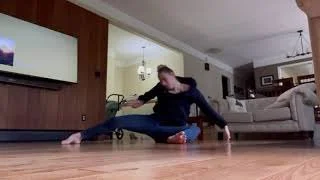Written Overview
Loop Ingredients:
A. Start lying face up on the floor. Roll onto 1 side of the body, then curl into a ball before expanding into a crescent / banana and back to a ball
B. Sweep through a seated position to swing outside leg into a lunge
C. Place hands onto the floor and transfer some weight into hands to lift feet off the ground
D. Spiral upper body towards the ground to find the floor and lay face up once again.
2. I tried to create a loop that allows the body to interact with the floor in quite different ways; in particular, I wanted to introduce different bases of support including the back-body, the hips, feet, and hands. I also wanted the loop to offer level changes, and the chance to add in a challenging skill; the main challenge in this loop is the transfer of weight into hands, allowing the hands to become the base of support so that as the loop progresses, less and less weight is born in the feet and eventually the hand-transfer could become a one-handed cartwheel. I also love starting a loop by lying down face up as a “home base” where you can rest or reorient yourself before continuing.
To get into the right headspace, I needed the right music and a song that I knew would be the right length and pace for this assignment. I needed my living room space to be cleared of inhibiting objects. I also needed to know my baby was sleeping so that I was less likely to be interrupted.
I really enjoyed the introduction; the assignment offered us a chance to open the loop by rocking or doing whatever movement would provide a gateway for the loop to flow. I stayed in the rocking probably longer than I initially intended to because it was feeling good. I also enjoyed the cartwheel progression - it was fun to feel the weightlessness moment and actually felt like less effort than keeping the feet close to the ground while transferring weight to the hands. I was very challenged in a few ways - my space felt too small, and I noticed my body wanting more room without worrying about hitting something. I have also been extremely challenged to find enough time and space to allow myself to really drop into movement due to the challenges of being a primary caregiver to an infant.
If there was something I would do differently, it would be trying to film at a time where I knew someone else was in charge of childcare, so part of my brain wasn’t distracted by trying to listen for sounds of a baby possibly waking up at the same time as thinking about the loop. The possibility of getting interrupted at any moment was definitely a flow blocker. I was also trying to keep the music low so as not to wake her, and normally louder music helps with my flow.
On reflection, I learned that it’s important not to rush into finding a flow state, but to really create the time and space to relax before attempting to flow or work on a loop. Relatedly, it’s very important to minimize distractions when trying to get into a flow and feel connected to our bodies.

